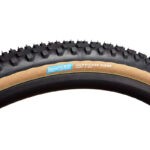I’d like to take a moment to hopefully explain what the TBD author was sharing.
Increased tire width is not a panacea and after running 45c Terra Speeds since May, it felt really nice to get back on 40s today. For me, the 45c’s handled like boats and feel less sure-footed while cornering. This could be due to the shape of the contact patch, or something else. Regardless, wider tires are slower to “get on edge†and feel more vague. Running lower pressures made the corner-feel worse, running higher pressures improved it but prevented the tire from getting good traction / conforming to the ground.
Now, for context, I run 2.5†tires on my 160/150mm travel mountain bike, 2.4’s on my 120mm mountain bike, and I’ve done BWR SanDiego on 28c Schwalbe ProOne’s. I’ve also run Tubular CX tires from Dugast, FMB, and Donnelly. I have no reason to run anything other than 33s on the CX bike and 40c is the sweet-spot for me on gravel / single track.
Many will cite that rocky terrain necessitates bigger tires. While I can appreciate that they make it “easierâ€, skills, higher pressures and inserts can all make up for any rim-strike / flat issues and I do not believe the loss in chunky terrain performance negates the improvement in cornering.
Now, regarding the linked article specifically. I think the author is spot on with their statement. Tire-pressure is king is cyclocross and a 33c tire at lower PSI has more grip than a larger tire at higher PSI given the same tread… Why are we comparing the larger tire at higher PSI? Because you cannot run the taller tires at low PSI without increased risk of the sidewall folding. When this happens, you lose all traction and it happens immediately, which is the sentiment the author was sharing. This is also apparent when comparing tubular and tubeless tires, which is why tubular is still ubiquitous at upper levels of the sport.
I will say that this is less relevant to gravel as we typically do not run truly low pressures like in CX (when I was racing at 165lbs, I ran between 19 (slick mud) and 26psi (hard / fast) range. However, you can still feels these affects - as noted above - at gravel widths and pressures.
Mark- where are you looking to optimize for? IMO Terra Speeds and Thundero’s are perfect all-around tires for this area. If you need more grip, drop the pressure 2psi at a time (~4 taps on the valve stem)
Edit to add: I’ve never run Typhoons or Grifo’s, but I have run FMB Sprints, which are similar-ish. They were magical in the right conditions: enough moisture in the soil than you left a tire-imprint but not enough moisture to call for a mud tire. When I was traveling and racing on the east coast this was great - and these conditions occur a lot in Europe. However, in the drier hardpack found here in Colorado, the MXP was a better intermediate tire as the knob design offered more mechanical grip without having to rely on suppleness.
![]()
